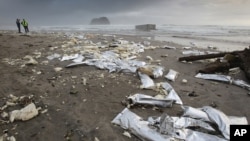The world's largest collection of ocean garbage floating in the Pacific Ocean, halfway between Hawaii and California, is now bigger than France, Germany and Spain combined.
The sprawling patch of detritus, known as the Great Pacific Garbage Patch, contains nearly 80,000 tons of plastic, a study released Thursday found.
Winds and converging ocean currents funnel the garbage into a central location, said the study's lead author, Laurent Lebreton of the Ocean Cleanup Foundation, a nonprofit organization that spearheaded the research.
Lebreton said the trash in the patch, discovered in the early 1990s, comes from countries around the Pacific Rim, including nations in Asia as well as North and South America.
The patch is not a solid mass of plastic. It includes 1.8 trillion pieces of plastic. The new figures are as much as 16 times higher than previous estimates.
While tiny fragments of plastic are the most numerous, nearly half of the weight of rubbish is composed of discarded fishing nets. Other items spotted in the stew of plastic include bottles, plates, buoys, ropes and even a toilet seat.
Caught by currents
Every year, millions of tons of plastic enter the ocean. Some of it drifts into large systems of circulating ocean currents, known as gyres. Once trapped in a gyre, the plastic will break down into microplastics, which may be ingested by sea life.
"I've been doing this research for a while, but it was depressing to see," Lebreton said.
The message of the study is clear, Lebreton said: "It goes back to how we use plastic."
"We're not going to get away from plastic — in my opinion, it's very useful, in medicine, transportation and construction. But I think we must divert the way we use plastic, particularly in terms of single-use plastic and those objects that have a very short service lifespan."
The study was based on a three-year mapping effort conducted by an international team of scientists affiliated with the Ocean Cleanup Foundation, six universities and an aerial sensor company.











